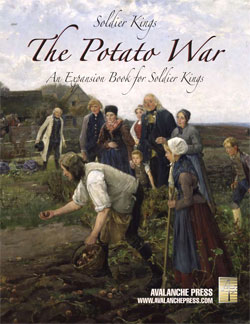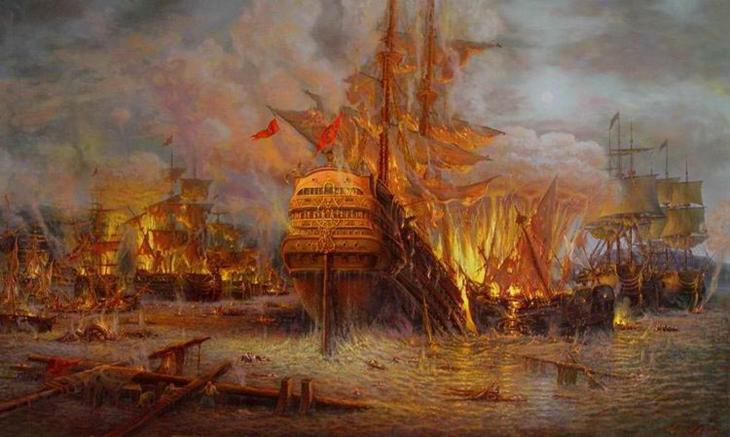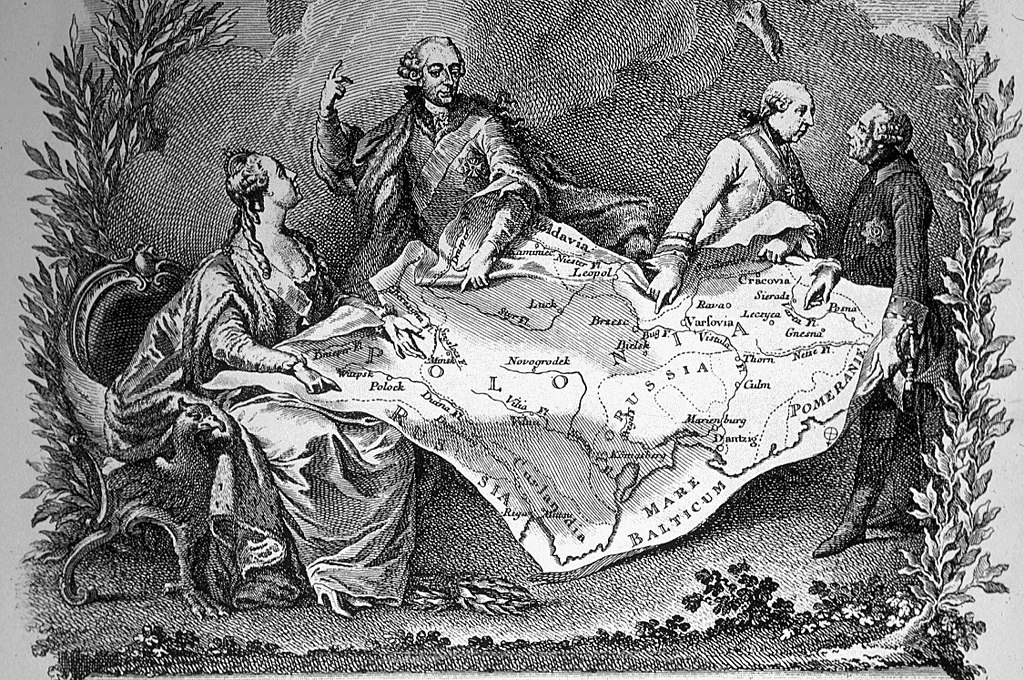The Potato War
The Russo-Ottoman War, Part Three
by Mike Bennighof, Ph.D.
March 2018
 We began the tale of the Russo-Ottoman War in Part One and continued it in Part Two. Here’s the rest of it. We began the tale of the Russo-Ottoman War in Part One and continued it in Part Two. Here’s the rest of it.
The Naval Campaign
As soon as Catherine and her advisors had determined to provoke war with the Ottoman Empire, her advisor and lover Grigori Orlov suggested sending a naval expedition into the Eastern Mediterranean to attack Ottoman territories and foment revolts against the Sultan. Russia had fought the Ottomans twice previously in the 18th Century, but in neither case had the Russian Baltic Fleet taken a hand in operations – the voyage was considered far beyond the capabilities of Russian ships and sailors.
Grigori and his brothers Fedor and Alexei had been working for years toward such an expedition, arranging contracts for supplies in Italian ports and British-ruled Minorca, contacting Greek dissidents and looking into an attempt to seize Corsica from the Republic of Genoa. Alexei received command of the expedition, despite having no naval experience. But he had done most of the groundwork for the scheme and knew the Italian and Greek contacts personally, and was considered an experienced diplomat. Admiral Grigori Spiridov had command of the First Squadron, taking over after repeated attempts to dodge the assignment led to a direct order from his empress.
Spiridov set out from Kronstadt in July 1769 with seven ships of the line and some supporting vessels. A few years before, the Royal Navy had begun experiments with copper sheathing to repel marine organisms that feasted on wooden hulls or clung to them and slowed the ship. The Russians tried their own version: a layer of sheep’s wool planked over with a layer of wood. The vessels wallowed like garbage scows; the trip from Kronstadt to Copenhagen, normally a voyage of seven days, took them thirty.
The Russian fleet – now down to five ships of the line – finally reached Minorca in the eastern Mediterranean in December 1769, and Malta in early February 1770. Later that month the fleet reached the Morea, the Greek peninsula known today as the Peloponnesus, and made contact with Alexei Orlov’s Greek rebels. Armed by the Russians, though only a handful of actual Russians came ashore to fight alongside them, the Greeks soon numbered thousands of rebels who attacked Turkish garrisons, murdered Muslim civilians and burned their villages.

Turkish flagship Real Mustafa aflame, Battle of Chesme.
As the revolt spread across the Morea, Crete and the Aegean Islands, the Turkish government could do little to stop it. Unwilling to detach troops from the grand vizier’s main army on the Danube – or perhaps unable to, given the chaotic nature of Turkish administration in this age of de-centralization – the Sultan’s government reacted to the crisis by shipping thousands of Muslim Albanian irregulars to the area. They in turn massacred thousands of Greek Christians and burned their villages.
Reinforced by four more ships of the line, the Russian fleet met a Turkish fleet of 16 ships of the line in Chesme Bay off the coast of Anatolia. Spiridov, in tactical command with his nominal boss Alexei Orlov looking on, brought the Russians into the attack in a line-ahead column aimed straight at the waiting Turks, a maneuver Horatio Nelson would use to good effect a generation later. While some of the Russians hesitated, Spiridov’s flagship went right at the Turkish flagship and the two engaged in a brutal close-range carronade interrupted by boarding actions until both ships caught fire and exploded. Spiridov survived – his second-in-command would later charge that he had abandoned ship before engaging the Turks – and the Turks attempted to flee, exposing themselves to the loss of 11 more ships of the line.
Following the battle the Turkish fleet withdrew behind the Dardanelles Strait; the Russians did not attempt to force their way past the fortifications there. The Russians received two more reinforcing squadrons, but the Turks did not come out to fight them. With the Greek revolt crushed, the Russians probed at other points along the Turkish coast, bombarding Beirut and landing troops there to exact a cash payment from the local governor. In all the Russians lost seven of the 20 ships of the line sent into the Mediterranean, most of them to poor maintenance and weak construction, while 4,500 of the 12,200 men sent on the expeditions died. While a serious setback for the Navy and a disaster for its sailors, the expedition carried out its intended purpose of pressuring the Sultan from an unexpected direction.
Year Three: 1771
As 1771 dawned, bubonic plague broke out in both the Russian and Turkish camps along the Danube. That drove both sides to spread out along the river and wage a brutal war of small-scale raid and counter-raid, while the main action moved eastward.
Vasili Dolgorukov replaced Peter Panin at Second Army, and in April 1771 he marched on Crimea with 53,000 men. Over the winter the Russians had not only bulked up their forces with transfers of new regiments and new recruits, but engaged in intensive secret diplomacy with both the Crimean and Nogai Tatars. With the bulk of Tatar forces in the Balkans with the grand vizier’s army and those remaining in Crimea wavering in their devotion to their Khan, the Russians struck at an opportune moment.

A Russian autocrat reaches out to take Crimea.
Dolgorukov reached Crimea in June. A long-standing wall over 25 feet high, fronted by a ditch 20 feet deep, barred the Perekop Isthmus leading to the rest of the peninsula, backed by 55,000 Tatars and 7,000 Turks. The Russians launched simultaneous night assaults on either end of the fortification, and their new Azov Flotilla landed troops along the Putrid Sea on the eastern shore of Crimea. Dolgorukov had studied the previous Russian breakthroughs into Crimea; in 1736 an invading force of 80,000 men lost 30,000 to thirst and dysentery. Invasions in 1737 and 1738 fared better by paying close attention to logistics and sanitation. Dolgorukov did so as well.
Less than 10 days after the breakthrough, Tatar nobles began appearing at Dolgorukov’s headquarters to propose a new arrangement with the Russians. The Russians continued their advance, capturing ports and fortresses as well as securing both sides of the Kerch Strait between the Sea of Azov and the Black Sea, yet avoiding battle with the Crimean horde – this time, unlike previous campaigns, the Russians hoped to turn the Crimean Tatars to their side rather than destroy them.
In July the Khan himself acknowledged Russian suzerainty over Crimea in exchange for a Russian guarantee of this throne. A few days later he abdicated and fled to Turkish territory; the Tatar nobility elected a new Khan who likewise accepted the Russians as overlords. Dolgorukov had turned the Sultan’s most valuable ally into a Russian vassal.
The pause along the Danube allowed the Russians to end the Polish insurrection. Alexander Suvorov, using unorthodox tactics, defeated and dispersed the Poles led by a borrowed French general, Charles Francois Dumouriez, who would lead the French revolutionary armies a generation later.
War’s End
With the Crimean and Polish fronts settled, the Russians looked to finish and possibly partition the Ottoman Empire. The Turks cast about for allies, and the Austrians agreed to mediate for peace in exchange for a hefty cash payment and assorted territorial concessions. The Austrians rejected Russia’s initial demands, considering them exorbitant, and began mobilizing troops and building roads and magazines along their border with Poland. When the Russians refused more reasonable terms, the Austrians signed a secret alliance with Turkey in June 1771, clearing the way for a widened war and distressing Empress Maria Theresa.
That prospect alarmed King Frederick of Prussia, who did not wish to see the balance of power upset by an Austrian defeat of Russia and domination of Turkey. Frederick opened secret negotiations with the Austrians and Russians, proposing the partition of Poland. Both could gain territory without the prospect of war, and Prussia could gain as well. The agreement was sealed in February 1772, but this did not end the war between Russia and Turkey.

Catherine, Joseph II and Frederick divide Poland while King Stanislaw looks on.
Austrian-mediated peace talks began in the spring of 1772 and continued for most of the year, with a cease-fire in place during the discussions. Russia began to run short of both cash and recruits, while the massive Cossack uprising known as the Pugachev Rebellion broke out in the southern Urals and began to spread. All of that put pressure on Rumyantsev to end the war by defeating the Ottoman field army and marching on Constantinople, but he could not do so until the line of Turkish fortresses along the Danube had been reduced. Those efforts consumed most of the 1773 campaign season.
Rumyantsev crossed the Danube in force in April 1774, and in June the Russians defeated the Ottoman field army – two column commanders, Suvorov and Mikhail Kamenski, claimed credit. That final defeat brought the Ottomans back to the table, and serious talks began to the Romanian village of Kuchuk-Kainarji. Two days of discussion brought an agreement, three more brought approval from the grand vizier, and the war came to a sudden end.
Though Turkey ceded very little actual Turkish territory, the Treaty of Kuchuk-Kainarji brought the Pontic Steppe under Russian control, as well as Russian domination over Crimea (formally annexed a decade later) and permanent, secure access to the Black Sea. Waves of settlers followed, with the Muslim inhabitants enslaved, massacred or driven out in what later generations would call ethnic cleansing. The Zaporozhian Cossacks had fought loyally alongside Rumyantsev; their brotherhood was liquidated and their people forced into serfdom or to flee to the Empire’s new borderlands (or Turkish territory) to resume their Cossack lifestyle.

Reaching a treaty proved less traumatic than this Turkish engraving suggests.
When the Partition of Poland – undertaken to prevent Austrian intervention in the war and therefore a direct result of the conflict – is included, Catherine had enormously expanded Russian territory and with it political and economic power. Had she failed, she likely would have met an “accident” similar to that which claimed her unloved husband’s life, but she won her gamble and became known as “the Great.”
Note: Our Soldier Kings: The Potato War expansion book is built around two conflicts that took place in the latter half of the 18th century: the Russo-Ottoman War of 1768 and the Potato War/American War of 1778.
Click here to order The Potato War right now.
Mike Bennighof is president of Avalanche Press and holds a doctorate in history from Emory University. A Fulbright Scholar and award-winning journalist, he has published over 100 books, games and articles on historical subjects.
He lives in Birmingham, Alabama with his wife, three children and his dog, Leopold.
|
